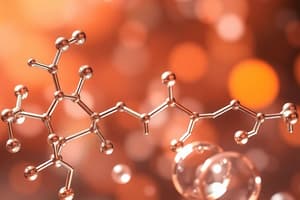Podcast
Questions and Answers
What role did sunlight play in the early chemical evolution on Earth?
What role did sunlight play in the early chemical evolution on Earth?
- It provided energy necessary for molecules to combine. (correct)
- It cooled the molecules allowing for bonding.
- It solely influenced the temperature of Earth.
- It limited the formation of complex molecules.
Which of the following is a key feature of the Chemical Evolution Hypothesis?
Which of the following is a key feature of the Chemical Evolution Hypothesis?
- Simple molecules changed into macromolecules without an intermediary.
- Heat was a necessary factor to promote the joining of compounds. (correct)
- Compounds only formed in the absence of any light.
- All molecules require oxygen for complex formation.
Why is studying chemistry crucial in the field of biology?
Why is studying chemistry crucial in the field of biology?
- It explains the environmental impact on living organisms.
- It focuses on the biodiversity of living organisms.
- It disregards the role of energy in biological systems.
- It helps understand how macromolecules are built from atoms. (correct)
Which of the following statements about atoms is correct?
Which of the following statements about atoms is correct?
Which of these molecules is not typically formed in the initial steps of chemical evolution?
Which of these molecules is not typically formed in the initial steps of chemical evolution?
What characteristic of early Earth’s atmosphere contributed to chemical evolution?
What characteristic of early Earth’s atmosphere contributed to chemical evolution?
What is the relationship between atoms and molecules in biological systems?
What is the relationship between atoms and molecules in biological systems?
What defines the energy levels in an atom?
What defines the energy levels in an atom?
What is the atomic number of an element indicative of?
What is the atomic number of an element indicative of?
Which of the following best describes a compound?
Which of the following best describes a compound?
What defines the term 'valence' in an element?
What defines the term 'valence' in an element?
What are isotopes?
What are isotopes?
Which method utilizes radioactive isotopes to determine the age of fossils?
Which method utilizes radioactive isotopes to determine the age of fossils?
Which statement about radioactive decay is accurate?
Which statement about radioactive decay is accurate?
What role do radioactive tracers play in medicine?
What role do radioactive tracers play in medicine?
Which of the following statements is true regarding elements essential to life?
Which of the following statements is true regarding elements essential to life?
Flashcards are hidden until you start studying
Study Notes
Chemical Evolution Theory
- Early Earth had simple molecules like formaldehyde (H₂CO) and hydrogen cyanide (HCN) needing energy, such as sunlight, to form.
- Sunlight enabled mixing of atmospheric compounds like carbon monoxide, carbon dioxide, hydrogen, ammonia, water, and nitrogen, leading to new compound formation.
- High temperatures facilitated the combination of single carbon compounds into complex molecules including acetaldehyde, glycine, and ribose, crucial for life's building blocks.
Importance of Chemistry in Biology
- Understanding Chemistry is essential for grasping how macromolecules (carbohydrates, lipids, proteins, nucleic acids) are constructed from atoms.
- Knowledge of chemistry clarifies the interactions and formations of these essential macromolecules that contribute to health and biological functions.
Atom Structure and Energy
- The atom resembles a mini solar system with energy levels represented as shelves: K (lowest energy), L (higher energy), M (even higher energy).
- Electrons closer to the nucleus possess less energy compared to those located further away.
Building Blocks of Chemical Evolution
- Each chemical element has a unique atomic number indicating the number of protons.
- The mass number shows the sum of protons and neutrons in the most common isotope of an element.
- Valence refers to unpaired electrons that can form connections, similar to additional building blocks in a structure.
Atoms and Matter
- Atoms are fundamental building blocks of matter, indivisible by standard methods.
- Different types of atoms constitute various substances, analogous to diverse building materials used in construction.
Chemical Elements and Compounds
- Matter is constituted of atoms, which can combine to form elements that cannot be broken down by chemical reactions.
- Compounds arise from the bonding of different elements, creating diverse structures and functionalities.
Isotopes
- Isotopes are variants of the same element with identical protons but differing neutrons.
- Some isotopes are unstable, undergoing radioactive decay, emitting particles or energy to achieve stability.
Uses of Radioactive Isotopes
- Radioactive Carbon Dating employs Carbon-14 (14C) to estimate the age of fossils and determine the time since a plant or animal's death.
- Radioactive tracers are utilized in medical imaging, such as PET scans, aiding in the diagnosis of cancer and examining organ conditions.
Elements Essential to Life
- Approximately 100 elements naturally exist on Earth, with a subset being crucial for biological processes and life structures.
Studying That Suits You
Use AI to generate personalized quizzes and flashcards to suit your learning preferences.




